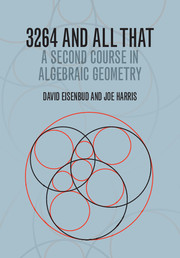Book contents
- Frontmatter
- Contents
- Preface
- Chapter 0 Introduction
- Chapter 1 Introducing the Chow ring
- Chapter 2 First examples
- Chapter 3 Introduction to Grassmannians and lines in ℙ3
- Chapter 4 Grassmannians in general
- Chapter 5 Chern classes
- Chapter 6 Lines on hypersurfaces
- Chapter 7 Singular elements of linear series
- Chapter 8 Compactifying parameter spaces
- Chapter 9 Projective bundles and their Chow rings
- Chapter 10 Segre classes and varieties of linear spaces
- Chapter 11 Contact problems
- Chapter 12 Porteous' formula
- Chapter 13 Excess intersections and the Chow ring of a blow-up
- Chapter 14 The Grothendieck Riemann–Roch theorem
- Appendix A The moving lemma
- Appendix B Direct images, cohomology and base change
- Appendix C Topology of algebraic varieties
- Appendix D Maps from curves to projective space
- References
- Index
Appendix D - Maps from curves to projective space
Published online by Cambridge University Press: 05 March 2016
- Frontmatter
- Contents
- Preface
- Chapter 0 Introduction
- Chapter 1 Introducing the Chow ring
- Chapter 2 First examples
- Chapter 3 Introduction to Grassmannians and lines in ℙ3
- Chapter 4 Grassmannians in general
- Chapter 5 Chern classes
- Chapter 6 Lines on hypersurfaces
- Chapter 7 Singular elements of linear series
- Chapter 8 Compactifying parameter spaces
- Chapter 9 Projective bundles and their Chow rings
- Chapter 10 Segre classes and varieties of linear spaces
- Chapter 11 Contact problems
- Chapter 12 Porteous' formula
- Chapter 13 Excess intersections and the Chow ring of a blow-up
- Chapter 14 The Grothendieck Riemann–Roch theorem
- Appendix A The moving lemma
- Appendix B Direct images, cohomology and base change
- Appendix C Topology of algebraic varieties
- Appendix D Maps from curves to projective space
- References
- Index
Summary
Keynote Questions
(a) What is the smallest degree of a nonconstant map from a general curve of genus g to ℙ1? (Answer on page 567.)
(b) In how many ways can a general curve C of genus 4 be expressed as a 3-sheeted cover of ℙ1, up to automorphisms of ℙ1? (Answer on page 577.)
(c) What is the smallest degree of a nondegenerate map from a general curve of genus g to ℙ2? (Answer on page 567.)
(d) In how many ways can a general curve C of genus 6 be expressed as a curve of degree 6 in ℙ2, up to automorphisms of ℙ2? (Answer on page 578.)
(e) What is the smallest degree of an embedding of a general curve of genus g in ℙ3? (Answer on page 567.)
(f) In how many ways can a general curve C of genus 8 be embedded as a curve of degree 9 in ℙ3, up to automorphisms of ℙ3? (Answer on page 578.)
In this book we have treated problems in enumerative geometry as interesting for the aspects of algebraic geometry that they illuminate, and for their own sake—there is a certain fascination with being able to enumerate solutions to a geometric problem, even when we cannot find those solutions explicitly. In this appendix we will see a striking example of another kind, where the methods of enumerative geometry are crucial in the analysis of a qualitative questions in geometry. We will describe and prove half of a foundational result in the theory of algebraic curves: the Brill–Noether theorem, which answers the question of when a general curve of given genus admits a map of given degree to projective space.
This material also illustrates the value of considering cycle theories other than the Chow ring of a variety. We will be working with Jacobians and symmetric powers of curves (see Section 10.3.1 for the definition and basic properties of symmetric powers in general, and Section D.2 below for a description of the Jacobian of a curve and its relation to the symmetric powers). These are spaces whose Chow rings remain opaque but whose cohomology rings are readily accessible (the Jacobian of a curve of genus g is homeomorphic to a product of 2g copies of S1, so we can apply the Künneth formula to give a compact description of its cohomology ring).
- Type
- Chapter
- Information
- 3264 and All ThatA Second Course in Algebraic Geometry, pp. 564 - 593Publisher: Cambridge University PressPrint publication year: 2016

